(捷进英语2)Unit4-电子教案
- 格式:doc
- 大小:52.50 KB
- 文档页数:5
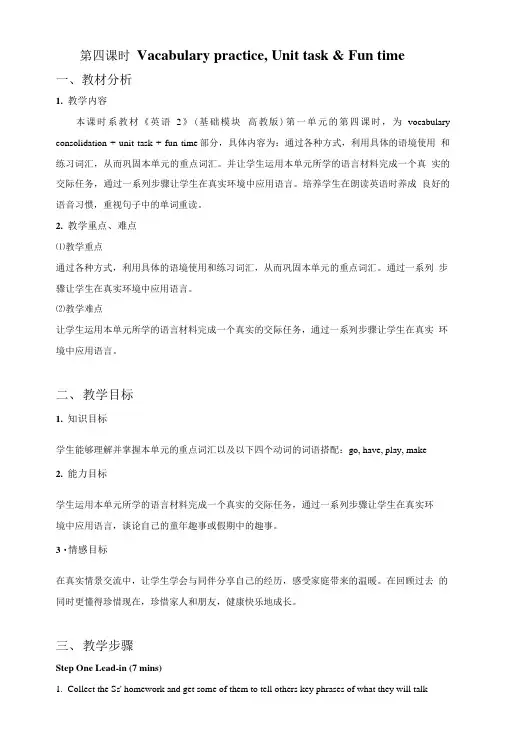
第四课时Vacabulary practice, Unit task & Fun time一、教材分析1.教学内容本课时系教材《英语2》(基础模块高教版)第一单元的第四课时,为vocabulary consolidation + unit task + fun time部分,具体内容为:通过各种方式,利用具体的语境使用和练习词汇,从而巩固本单元的重点词汇。
并让学生运用本单元所学的语言材料完成一个真实的交际任务,通过一系列步骤让学生在真实环境中应用语言。
培养学生在朗读英语时养成良好的语音习惯,重视句子中的单词重读。
2.教学重点、难点⑴教学重点通过各种方式,利用具体的语境使用和练习词汇,从而巩固本单元的重点词汇。
通过一系列步骤让学生在真实环境中应用语言。
⑵教学难点让学生运用本单元所学的语言材料完成一个真实的交际任务,通过一系列步骤让学生在真实环境中应用语言。
二、教学目标1.知识目标学生能够理解并掌握本单元的重点词汇以及以下四个动词的词语搭配:go, have, play, make2.能力目标学生运用本单元所学的语言材料完成一个真实的交际任务,通过一系列步骤让学生在真实环境中应用语言,谈论自己的童年趣事或假期中的趣事。
3・情感目标在真实情景交流中,让学生学会与同伴分享自己的经历,感受家庭带来的温暖。
在回顾过去的同时更懂得珍惜现在,珍惜家人和朋友,健康快乐地成长。
三、教学步骤Step One Lead-in (7 mins)1.Collect the Ss' homework and get some of them to tell others key phrases of what they will talktoday. Get others to guess.SI (Li Jie): went swimming bathed in the sun walked along the beachT: What did Li Jie do last vacation?S2: She went swimming, bathed in the sun and walked along the beach.T: Where did she go?53to SI: Did you go to Sanya?SI: No, I didn't.54to S1: Did you go to Qingdao?S1: No, I didn't. I went to Thailand.T: Who did she go with?55to SI: Did you go with your parents?SI: Yes, I did.(设计意图:这一步骤教师既能对学生的作业情况进行及时地检查,教师在并听的过程中边提出问题,并且问题是结合上一课时的知识点,又可以检查学生们对于一般过去时的掌握情况。
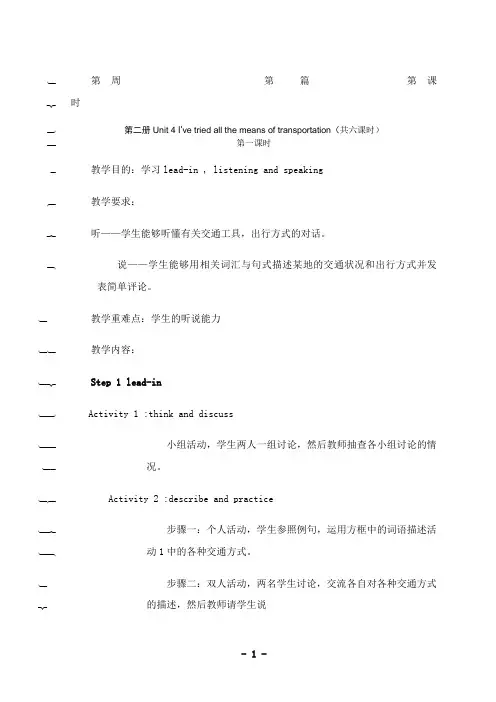
第周第篇第课时第二册Unit 4 I’ve tried all the means of transportation(共六课时)第一课时教学目的:学习lead-in , listening and speaking教学要求:听——学生能够听懂有关交通工具,出行方式的对话。
说——学生能够用相关词汇与句式描述某地的交通状况和出行方式并发表简单评论。
教学重难点:学生的听说能力教学内容:Step 1 lead-inActivity 1 :think and discuss小组活动,学生两人一组讨论,然后教师抽查各小组讨论的情况。
Activity 2 :describe and practice步骤一:个人活动,学生参照例句,运用方框中的词语描述活动1中的各种交通方式。
步骤二:双人活动,两名学生讨论,交流各自对各种交通方式的描述,然后教师请学生说出描述,再给出反馈。
Step 2 listening and speakingA 听前准备听前让学生看表格中所提到的公共交通方式,以头脑风暴的形式进行预测,目的是帮助学生初步了解对话的内容。
B 听力理解教学Activity 3 : listen and tickActivity 4 : listen and answerActivity 5 :listen and completeC听力表达教学Activity 6 :listen read and underlineD口语教学Activity 7 :interview and complete【注释】1.I’ve tried all the means of transportation★transportation (n.)交通运输系统○The city needs to improve its public transportation.★means (n.)方法,手段○The quickest means of travel is by plane.最快的交通工具是飞机。
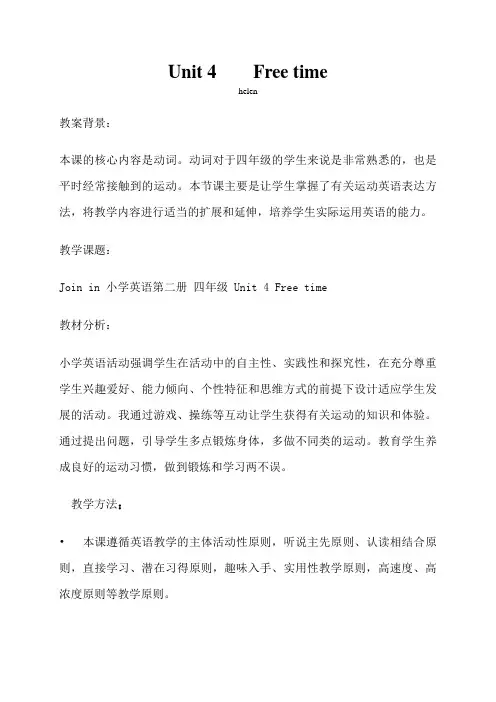
Unit 4 Free timehelen教案背景:本课的核心内容是动词。
动词对于四年级的学生来说是非常熟悉的,也是平时经常接触到的运动。
本节课主要是让学生掌握了有关运动英语表达方法,将教学内容进行适当的扩展和延伸,培养学生实际运用英语的能力。
教学课题:Join in 小学英语第二册四年级 Unit 4 Free time教材分析:小学英语活动强调学生在活动中的自主性、实践性和探究性,在充分尊重学生兴趣爱好、能力倾向、个性特征和思维方式的前提下设计适应学生发展的活动。
我通过游戏、操练等互动让学生获得有关运动的知识和体验。
通过提出问题,引导学生多点锻炼身体,多做不同类的运动。
教育学生养成良好的运动习惯,做到锻炼和学习两不误。
教学方法:•本课遵循英语教学的主体活动性原则,听说主先原则、认读相结合原则,直接学习、潜在习得原则,趣味入手、实用性教学原则,高速度、高浓度原则等教学原则。
•课堂教学以“ Can you....? Yes,I can. / No, I can’t.”为主题,以每位学生对某项运动会与否为主线贯穿始终。
学生积极主动地学习英语,并将所学的知识自然有效地运用于生活实际,收到了较好的成效。
•活动内容贴近学生的学习和生活,实用意义大。
待孩子们基本掌握句型之后,鼓励他们积极进行对话,让所学的知识得到升华,并把升华后的知识转变成为真实交际的能力。
•整堂课设计以游戏、操作、律动为主,如:“根据情景问答”、等活动,有效地提高了学生学习的趣味性。
•设置的目标符合学生的接受能力,全体学生都能参与,可操作性强,通过自主学习,人人都能或多或少地获得成就感,提高了学生学习的兴趣和参与的积极性。
活动准备:•单词、句子卡片若干。
•教具。
•有学生运动生活照片若干。
•大灰狼头饰。
Unit 4 Free timehelenUnit Four Period 1Teaching objectives:1.Learn to use: play table tennis, play the piano, stand on your head, playfootball, swim, roller blade, ski, ride a horse.2.Sentences: Can you…? Yes, I can./ No, I can’t.Teaching key and difficult points:Learn to use the new words and use the sentence patterns to ask and answer.区分好乐器与球类,注明乐器前面要加“the”.Teaching aids:Pictures, recorder, slide projector, word cardsTeaching procedure:1.Warm-up: watch and sing a flash. Sing and do the actions.2.Presentation1) Let Ss look some pictures about the opening ceremony of the Asian Games. To know five sheep about the Asian Games.Show the pictures about langlang, he can play the piano very well. Teach the words: play the piano.2) All Ss read after teacher, then read it one by one. Or group read.3) Teach the other words in the same way. Use different superstars to lead out the other words.4) Let the pupils to repeat the words after the tape.3.Consolidation1).Play the games:A. Listen and put the words under the right pictures.B. Listen and do the actions: one pupil do the actions, let another pupil to guess the words.C. Guess the words.D. leader game.2) Pair work:Make a survey: Use the sentence patterns to ask their friends.Homework:A. Copy the new words.B. Use the sentence patterns to ask their friends.Unit 4 Free time教学反思Helen Chan我上的是四年级Unit 4 Free time的新授课。

Unit 4 Wildlife protectionTeaching goals*语言知识1.to talk about endangered species.2.to understand the importance of wildlife protection3.to know how to express your intentions and purposes4.to learn to use the Present Progressive Passive V oice5.to learn how to write a letter of advice*语言技能和学习策略1.to develop listening skills by doing exercises in listening task2.to develop speaking skills by finishing the speaking task and other activities like discussion andoral practice3.to develop reading skills through the reading materials in this unit4.to learn to write a letter of advice*文化意识1.to know the reason for the endangered animal’s dying out2.to know the importance and necessity of wildlife protection*情感态度1.to raise the students’ sense of wildlife protection*单元整体设计思路:第一、二、三课时Warming Up, Pre-reading, Reading, Comprehending, Speaking第四课时Learning about Language& Discovering useful structures第五课时Using language第六课时Speaking and writing第七课时Summing up, self-evaluation and self-test/exercisesTeaching key points:1.how to improve students’ speaking and cooperating abilities2.learn to use the present progressive passive voice3.master some words and expressionsTeaching difficult points:1.train the students’ speaking, listening, reading and writing abilities2.how t o improve students’ cooperating abilitiesTeaching methods:Student-focus approach and task-based approachLearning methods:Cooperative studyTeaching aids:ComputerPeriod 1 ,2&3 Warming Up, Pre-reading, Speaking, Reading, Comprehending, Teaching Goals: 1. To talk about endangered species2. To read about and understand wildlife protectionTeaching Procedures:Step 1. Lead-inShow some pictures of some endangered animals and let the students name them. (polar bear, milu deer, rhino, tiger, crocodile, leopard, koala, panda, dolphin, giraffe…)Questions: 1. Do you often see these animals?2. What problems are some animals facing nowadays? Why?Step 2. Warming up& SpeakingCooperative learning: discuss the questions with the partners.1. Why are the animals in danger?(1. Don’t have enough food; 2. Being hunted and killed ; 3. The bad environment; )2. What measures should be taken to protect the endangered animals?((1) Treat the animals as our friends; (2) We shouldn’t kill them freely. (3) We should protect the environment around us. (4) We should collect money to protect animals. (5)Protect their habitats and create new ones (6)S top buying clothes made of their furs …)Step 3. ReadingTask 1: Scanning1. What three places has she been to?2. What problems face the animals?3. What endangered animals are they?Task 2: Skimming1. Read the passage carefully and fill in the chart on page 27.2. Answer the questions. (P27)Task 3: Listen and read aloud.Step 4 SummaryFill in the blanks.How Daisy Learn to Help Wildlife1.Tibet: (1) ___________ is used to make sweater.(2) Antelopes are killed for ________;(3) Every year over ___________ antelopes are killed.2.Zimbabwe; (1) ________ used to hunt the elephants.(2) Now farmers __________ them.3.Rainforest: (1) A ________ insect affects mosquitoes.(2) No ______, no ________ and no _________.Step 5 Language points1.protection n. 保护protect vt. ~sth. from/against…保护……避免……He’s wearing the sunglasses to protect his eyes from/against the strong sunshine.2.die out灭亡;逐渐消失Many animals have died out in the past decades.*die away 慢慢减弱直至消失, die of/from 死于, die off 一个接一个死去3.loss n.His death is a loss of our country.The earthquake caused a loss of more than 20,000,000 yuan.*at a loss不知所措I’m at a loss what to do?4. Daisy had always longed to help endangered species of wildlife.(L1,P26)戴西一直想要帮助濒危动物.long: v. 渴望、非常想long to do 渴望做某事, long for …渴望……The children are longing to see you again. 孩子们盼望再见到你。
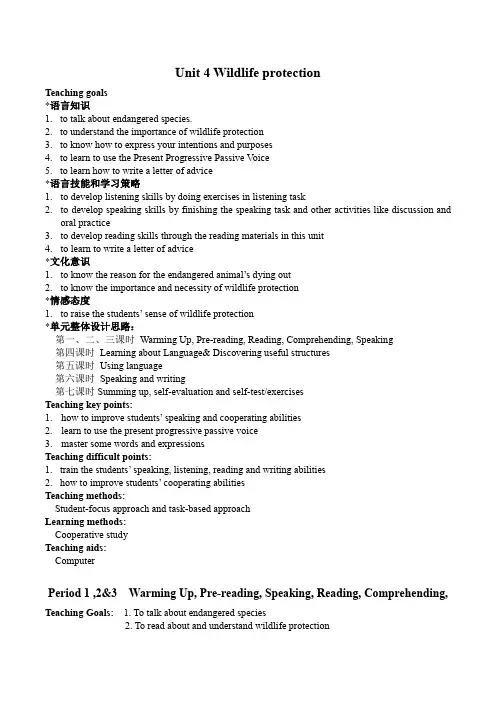
Unit 4 Wildlife protectionTeaching goals*语言知识1.to talk about endangered species.2.to understand the importance of wildlife protection3.to know how to express your intentions and purposes4.to learn to use the Present Progressive Passive V oice5.to learn how to write a letter of advice*语言技能和学习策略1.to develop listening skills by doing exercises in listening task2.to develop speaking skills by finishing the speaking task and other activities like discussion andoral practice3.to develop reading skills through the reading materials in this unit4.to learn to write a letter of advice*文化意识1.to know the reason for the endangered animal’s dying out2.to know the importance and necessity of wildlife protection*情感态度1.to raise the students’ sense of wildlife protection*单元整体设计思路:第一、二、三课时Warming Up, Pre-reading, Reading, Comprehending, Speaking第四课时Learning about Language& Discovering useful structures第五课时Using language第六课时Speaking and writing第七课时Summing up, self-evaluation and self-test/exercisesTeaching key points:1.how to improve students’ speaking and cooperating abilities2.learn to use the present progressive passive voice3.master some words and expressionsTeaching difficult points:1.train the students’ speaking, listening, reading and writing abilities2.how t o improve students’ cooperating abilitiesTeaching methods:Student-focus approach and task-based approachLearning methods:Cooperative studyTeaching aids:ComputerPeriod 1 ,2&3 Warming Up, Pre-reading, Speaking, Reading, Comprehending, Teaching Goals: 1. To talk about endangered species2. To read about and understand wildlife protectionTeaching Procedures:Step 1. Lead-inShow some pictures of some endangered animals and let the students name them. (polar bear, milu deer, rhino, tiger, crocodile, leopard, koala, panda, dolphin, giraffe…)Questions: 1. Do you often see these animals?2. What problems are some animals facing nowadays? Why?Step 2. Warming up& SpeakingCooperative learning: discuss the questions with the partners.1. Why are the animals in danger?(1. Don’t have enough food; 2. Being hunted and killed ; 3. The bad environment; )2. What measures should be taken to protect the endangered animals?((1) Treat the animals as our friends; (2) We shouldn’t kill them freely. (3) We should protect the environment around us. (4) We should collect money to protect animals. (5)Protect their habitats and create new ones (6)S top buying clothes made of their furs …)Step 3. ReadingTask 1: Scanning1. What three places has she been to?2. What problems face the animals?3. What endangered animals are they?Task 2: Skimming1. Read the passage carefully and fill in the chart on page 27.2. Answer the questions. (P27)Task 3: Listen and read aloud.Step 4 SummaryFill in the blanks.How Daisy Learn to Help Wildlife1.Tibet: (1) ___________ is used to make sweater.(2) Antelopes are killed for ________;(3) Every year over ___________ antelopes are killed.2.Zimbabwe; (1) ________ used to hunt the elephants.(2) Now farmers __________ them.3.Rainforest: (1) A ________ insect affects mosquitoes.(2) No ______, no ________ and no _________.Step 5 Language points1.protection n. 保护protect vt. ~sth. from/against…保护……避免……He’s wearing the sunglasses to protect his eyes from/against the strong sunshine.2.die out灭亡;逐渐消失Many animals have died out in the past decades.*die away 慢慢减弱直至消失, die of/from 死于, die off 一个接一个死去3.loss n.His death is a loss of our country.The earthquake caused a loss of more than 20,000,000 yuan.*at a loss不知所措I’m at a loss what to do?4. Daisy had always longed to help endangered species of wildlife.(L1,P26)戴西一直想要帮助濒危动物.long: v. 渴望、非常想long to do 渴望做某事, long for …渴望……The children are longing to see you again. 孩子们盼望再见到你。
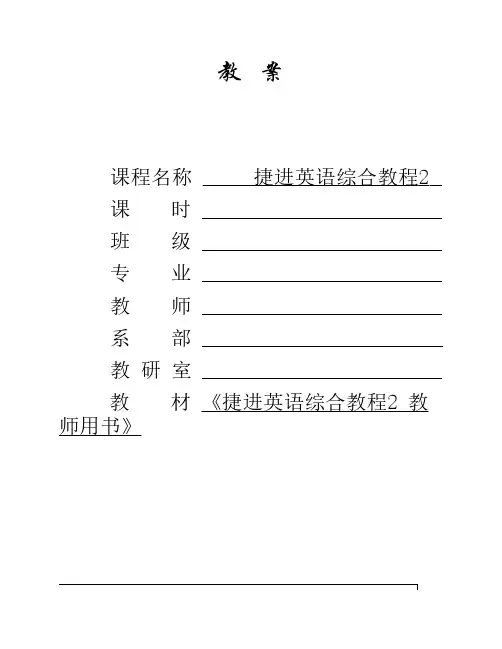
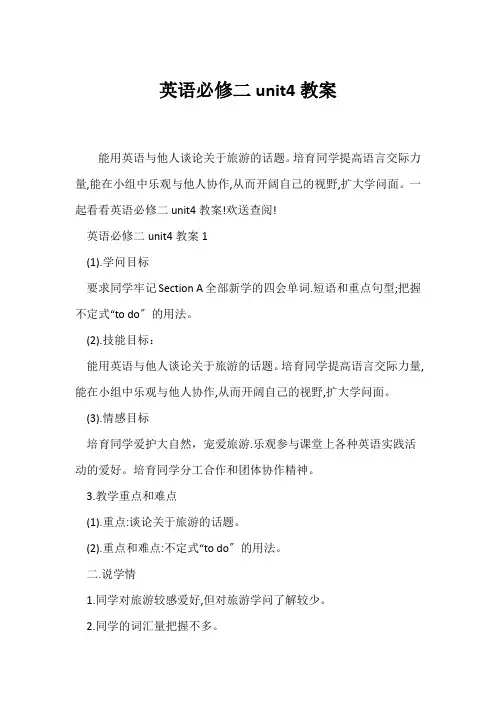
英语必修二unit4教案能用英语与他人谈论关于旅游的话题。
培育同学提高语言交际力量,能在小组中乐观与他人协作,从而开阔自己的视野,扩大学问面。
一起看看英语必修二unit4教案!欢送查阅!英语必修二unit4教案1(1).学问目标要求同学牢记Section A全部新学的四会单词.短语和重点句型;把握不定式“to do〞的用法。
(2).技能目标:能用英语与他人谈论关于旅游的话题。
培育同学提高语言交际力量,能在小组中乐观与他人协作,从而开阔自己的视野,扩大学问面。
(3).情感目标培育同学爱护大自然,宠爱旅游.乐观参与课堂上各种英语实践活动的爱好。
培育同学分工合作和团体协作精神。
3.教学重点和难点(1).重点:谈论关于旅游的话题。
(2).重点和难点:不定式“to do〞的用法。
二.说学情1.同学对旅游较感爱好,但对旅游学问了解较少。
2.同学的词汇量把握不多。
3. 同学平常较少用英语与他人交谈并表达信息.。
三.说教法学法依据课程改革的要求,遵循“老师由主演化导演,同学由配角变主角〞的角色转换,接受把课堂交给同学的教学理论,我运用自由争辩.分组工作.结对练习.问答练习等方法,借助多媒体、录音机,图片等教学手段,设置特定的语言环境,使同学在轻松开心的气氛中理解.运用英语。
四.说教学程序我设计了以下的步骤来训练同学的听.说.读.写的力量,尤其是他们“说〞的力量。
(一)温故知新(1).请两位同学用上节课重点句型号,分别复述Unit 5 Topic3 SectionD 1a(2).老师与同学之间进行问答对话,让同学谈论关于他们最宠爱的旅游方式。
设计意图:稳固上节课学过的学问,为学习新课铺垫。
(二)情景导入用多媒体呈现一些关于旅游和交通的图片,来引起同学的爱好,并由此教学本节课的新单词,如:field ,trip ,cycle ,vehicle ,airline等。
设计意图:通过用多媒体呈现同学生疏的交通工具图片,激发同学的学习爱好,轻松把握新单词,顺当带入新课。
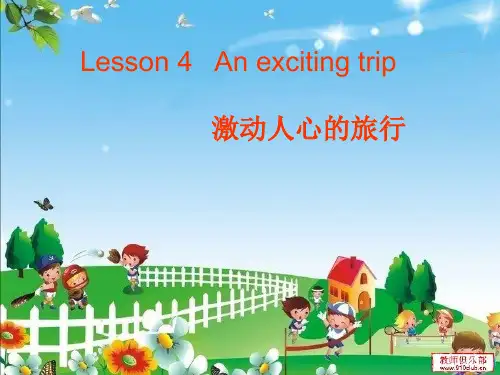
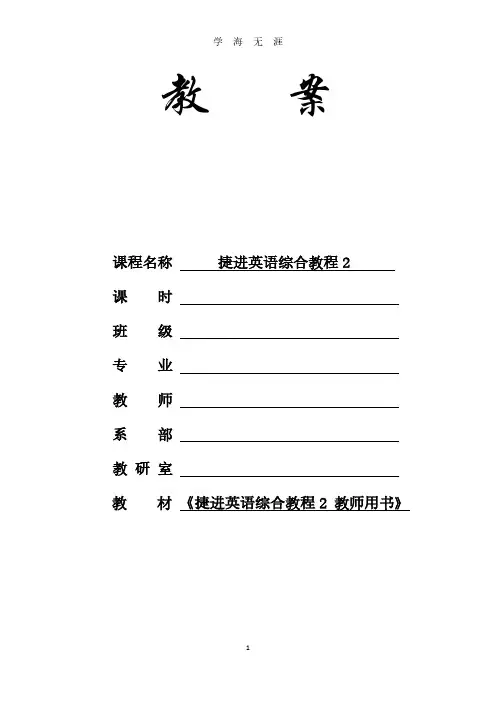
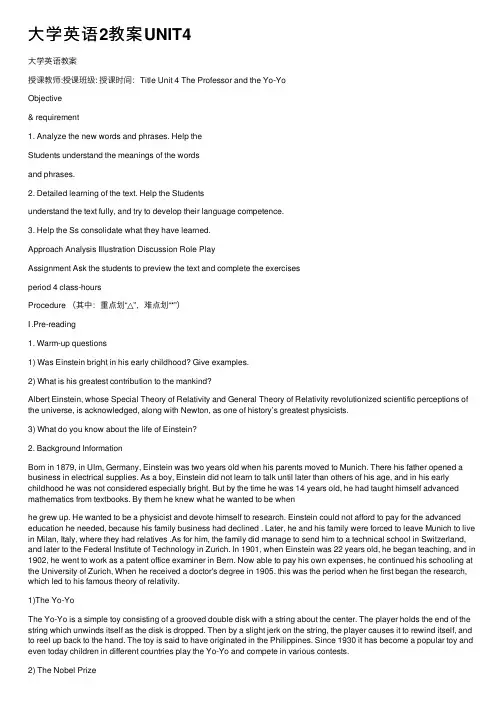
⼤学英语2教案UNIT4⼤学英语教案授课教师:授课班级: 授课时间:Title Unit 4 The Professor and the Yo-YoObjective& requirement1. Analyze the new words and phrases. Help theStudents understand the meanings of the wordsand phrases.2. Detailed learning of the text. Help the Studentsunderstand the text fully, and try to develop their language competence.3. Help the Ss consolidate what they have learned.Approach Analysis Illustration Discussion Role PlayAssignment Ask the students to preview the text and complete the exercisesperiod 4 class-hoursProcedure (其中:重点划“△”,难点划“*”)Ⅰ.Pre-reading1. Warm-up questions1) Was Einstein bright in his early childhood? Give examples.2) What is his greatest contribution to the mankind?Albert Einstein, whose Special Theory of Relativity and General Theory of Relativity revolutionized scientific perceptions of the universe, is acknowledged, along with Newton, as one of history’s greatest physicists.3) What do you know about the life of Einstein?2. Background InformationBorn in 1879, in Ulm, Germany, Einstein was two years old when his parents moved to Munich. There his father opened a business in electrical supplies. As a boy, Einstein did not learn to talk until later than others of his age, and in his early childhood he was not considered especially bright. But by the time he was 14 years old, he had taught himself advanced mathematics from textbooks. By them he knew what he wanted to be whenhe grew up. He wanted to be a physicist and devote himself to research. Einstein could not afford to pay for the advanced education he needed, because his family business had declined . Later, he and his family were forced to leave Munich to live in Milan, Italy, where they had relatives .As for him, the family did manage to send him to a technical school in Switzerland, and later to the Federal Institute of Technology in Zurich. In 1901, when Einstein was 22 years old, he began teaching, and in 1902, he went to work as a patent office examiner in Bern. Now able to pay his own expenses, he continued his schooling at the University of Zurich, When he received a doctor's degree in 1905. this was the period when he first began the research, which led to his famous theory of relativity.1)The Yo-YoThe Yo-Yo is a simple toy consisting of a grooved double disk with a string about the center. The player holds the end of the string which unwinds itself as the disk is dropped. Then by a slight jerk on the string, the player causes it to rewind itself, and to reel up back to the hand. The toy is said to have originated in the Philippines. Since 1930 it has become a popular toy and even today children in different countries play the Yo-Yo and compete in various contests.2) The Nobel PrizeNobel Prizes are annual monetary awards granted to individuals or institutions for outstanding contributions in the fields of physics, chemistry, physiology or medicine, literature, international peace, and economic sciences. The Nobel Prizes are internationally recognized as the most prestigious awards in each of these fields. The prizes were established by Swedish inventor and industrialist Alfred Bernhard Nobel, who set up a fund for them in his will. The first Nobel Prizes were awarded on December 10, 1901, the fifth anniversary of Nobel’s death. 3) Woolworth’sFrank Winfield Woolworth (1852~1919), an American merchant, was born in Rodman, New York. He established in 1879 a five-cent store at Utica, New York, which failed, and the same year he started a successful five-and-ten-cent store at Lancaster, Pennsylvania. Woolworth opened many others and soon extended business throughout the United States and to several foreign countries. In 1911 the F. W. Woolworth Company was incorporated with ownership of over 1,000 five-and-tens, and he becamedirector of various financial firms. (The last Woolworth stores were closed in 1998.) Woolworth had the Woolworth Building erected in New York City in 1913, the highest building in the world (792 ft / 241.4 m) at that time.3. Introductory remarksEinstein is one of the greatest scientists of all time. His ideas and theories have, directly or indirectly, influenced many areas of the modern world---science, art, and philosophy. In spite of his great achievements and fame, he always remained a simple man: he was honest and open, very easy to get along with; he lived a plain life and had simple habits, caring very little for material well-being. And the text The Professor and the Yo-Yo, whose author is the son of a close friend of Einstein’s, sheds more light on his personality both as a scientist and as a man.Ⅱ. Global readingIII. Detailed reading△1. at ease: in a relaxed positionHe put the soldiers at ease while waiting for inspection.The doctor soon made the worried mother feel at ease.Collocation:with ease轻⽽易举地;毫不费⼒地ill at ease不安;⼼神不宁(stand) at ease稍息/ (come to/stand at) Attention⽴正!take one’s ease 使⾃⼰舒服⼀下;休息;放松2. display : 1) vt. showThe children's work was displayed on the wall.The art museum is planning to display the new paintings it has bought.艺术博物馆正准备展出它买的新画。
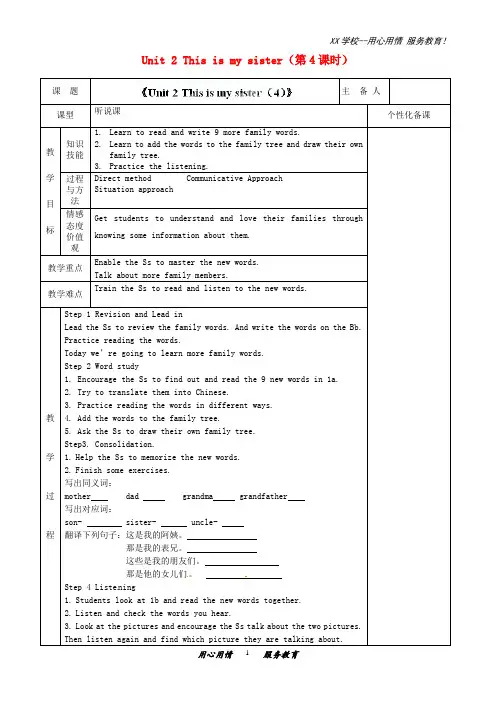
Unit 2 This is my sister(第4课时)课题主备人课型听说课个性化备课教学目标知识技能1.Learn to read and write 9 more family words.2.Learn to add the words to the family tree and draw their ownfamily tree.3.Practice the listening.过程与方法Direct method Communicative ApproachSituation approach情感态度价值观Get students to understand and love their families through knowing some information about them.教学重点Enable the Ss to master the new words. Talk about more family members.教学难点Train the Ss to read and listen to the new words.教学过程Step 1 Revision and Lead inLead the Ss to review the family words. And write the words on the Bb. Practice reading the words.Today we’re going to learn more family words.Step 2 Word study1. Encourage the Ss to find out and read the 9 new words in 1a.2. Try to translate them into Chinese.3. Practice reading the words in different ways.4. Add the words to the family tree.5. Ask the Ss to draw their own family tree.Step3. Consolidation.1.Help the Ss to memorize the new words.2.Finish some exercises.写出同义词:mother dad grandma grandfather写出对应词:son- sister- uncle-翻译下列句子:这是我的阿姨。
最新英语必修二unit4课文原文+单词+音标电子教案Unit 4 Wildlife protectionHOW DAISY LEARNED TO HELP WLDLIFEDaisy had always longed to help endangered species of wildlife. One day she woke up and found a flying carpet by her bed."Where do you want to go?"it asked. Daisy responded immediately."I'd like to see some endangered wildlife,"she said. "Please take me to a distant land where I can find the animal that gave fur to make this sweater." At once the carpet flew a way and took her to Tibet. There Daisy saw an antelope looking sad. It said, "We're being killed for the wool beneath our stomachs. Our fur is being used to make sweaters for people like you. As a result, we are now an endangered species." At that Daisy cried, "I'm sorry I didn't know that. I wonder what is being done to help you. Flying carpet, please show me a place where there's some wildlife protection."The flying carpet travelled so fast that next minute they were in Zimbabwe. Daisy turned around and found that she was being watched by an elephant. "Have you come to take my photo?" it asked. In relief Daisy burst into laughter."Don't laugh ,” said the elephant, "We used to be an endangered species. Farmers hunted us without mercy. They said we destroyed the ir farms, and money from tourists only went to the large tour companies. So the government decided to help. They allowe d tourists to hunt only a certain number of animals if they paid the farmers. Now the farmers are happy and our numbers are increasing. So good things are being done here to save local wildlife."Daisy smiled."That's good news. It shows the importance of wildlife protection, but I'd like to help as the WWF suggests. "Thecarpet rose again and almost at once they were in a thick rainforest.A monkey watched them as it rubbed itself."What are you doing?" asked Daisy. ”I’m protecting myself from mosquitoes," it replied. "When I find a millipede insect, I rub it over my body.It contains a powerful drug which affects mosquitoes.You should pay more attention to the rainforest where I live and appreciate how the animals live together. No rainforest, no animals, no drugs."Daisy was amazed. "Flying carpet, please take me home so I can tell WWF and we can begin producing this new drug. Monkey, please come and help." The monkey agreed. The carpet flew home. As they landed, things began to disappear. Two minutes later everything had gone - the monkey, too. So Daisy was not able to make her new drug. But what an experience! She had learne d so much! And there was always WWF…Book 2 Unit 4wildlife /'wa?ldla?f/ n. 野生动植物protection /pr?'tek?n/ n. 保护wild /wa?ld/ adj. 野生的;野的;未开发的;荒凉的△ habitat /'h?b?t?t/ n. 栖息地(动植物的)自然环境△ threaten /'θret?n/ vt. & vi. 恐吓;威胁decrease /d?'kri:s/ vi. & vt. 减少;(使)变小;或变少△ endanger /?n'de?nd??/ vt. 危害;使受到危险die out 灭亡;逐渐消失loss /l?s/ n. 损失;遗失;丧失reserve /r?'z?:v/ n. 保护区hunt /h?nt/ vt. & vi. 打猎;猎取;搜寻zone /z??n/ n. 地域;地带;地区in peace 和平地;和睦地;安详地in danger (of) 在危险中;垂危△ Daisy /'de?z?/ n.戴茜(女名)△ species /'spi:??:z/ n. 种类;物种carpet /'kɑ:p?t/ n. 地毯respond /r?'sp?nd/ vi. 回答;响应;做出反应distant /'d?st?nt/ adj. 远的;远处的fur /f?:/ n. 毛皮;毛;软毛△ antelope /'?nt?l??p/ n. 羚羊△ Zimbabwe /z?m'ba:bwe?/ n.津巴布韦(非洲东南部国家) relief /r?'li:f/ n. (痛苦或忧虑的)减轻或解除;减轻痛苦的事物in relief 如释重负;松了口气 laughter /'lɑ:ft?/ n. 笑;笑声burst into laughter 突然笑起来;大声笑了出来mercy /'m?:s?/ n. 仁慈;宽恕;怜悯certain /'s?:tn/ adj. 确定的;某一;一定importance /?m'p?:t?ns/ n. 重要(性)△ WWF (World Wildlife Fund) 世界野生生物基金会rub /r?b/ vt. 擦;摩擦protect … from 保护……不受……(危害)mosquito /m?'ski:t??/ n. 蚊子△ millipede /'m?l?pi:d/ n.(=millepede)千足虫insect /'?nsekt/ n. 昆虫contain /k?n'te?n/ vt. 包含;容纳;容忍powerful /'pa??fl/ adj. 强大的;有力的affect /?'fekt/ vt. 影响;感动;侵袭attention /?'ten?n/ n. 注意;关注;注意力pay attention to 注意appreciate /?'pri:??e?t/ vt. 鉴赏;感激;意识到succeed /s?k'si:d/ vi. 成功 vt. 接替;继任△Indonesia /?nd??'ni: ??;-z??/ n.印度尼西亚 (东南亚岛国)△ rhino /'ra?n??/ n. 犀牛secure /s?'kj??/ adj. 安全的;可靠的income /'??k?m; '?nk?m/ n. 收入employ /?m'pl??/ vt. 雇用;利用(时间、精力等)harm /hɑ:m/ n. & vt. 损害;危害△ Milu deer麋鹿bite /ba?t/ vt. & vi.(bit,bitten) 咬;叮;刺痛△ extinction /?k'st??k?n/ n. 灭绝;消亡dinosaur /'da?n?s?:/ n. 恐龙come into being 形成;产生△ county /'ka?nt?/ n. 县;郡inspect /?n'spekt/ vt. 检查;视察△ unexpected /?n?k'spekt?d/ adj. 没料到的;意外的incident /'?ns?d?nt/ n. 事件;事变dust /d?st/ n. 灰尘;尘土;尘埃according to 按照;根据……所说△ Mauritius /m?'rs/ n.毛里求斯 (非洲东部岛国)△ disappearance /d?s?'p??r?ns/ n. 消失fierce /f??s/ adj. 凶猛的;猛烈的so that 以致于;结果ending /'end??/ n. 结局;结尾△ faithfully /'fe?θf?l?/ adv. 忠诚地;忠实地△ Colobus /'k?l?b?s/ monk ey (非洲产)疣猴,髯猴II---IV Wildlife protection单项选择1. It seemed that he was______ losing his life. Luckily, he was______ in the end.A. in the danger of; out of dangerB. in danger of; out of danger;C. in the danger; out of the danger;D. in danger of ; out of the danger;2. More attention should be ___ equipment in our factory so that we can increase our productionA. paid to improving; B paid to improve; C taked to improveD. taken to improving;3. He was at a ______ what to say to the teacher’s question----obviously he was _____ in thought just now.A. loss; losing;B. loss; ;lost; C losing; lost; D. lost; loss;4. Have a good rest, and you need to _____ your energy for the tennis match this afternoon.A. leave;B. reserve;C. hold;D. get;5. Two thirds of the area______ with green grass or tall trees.A. is covered;B. are covered;C. is covering;D. are covering;6. Has the doctor suggested _______ close attention to your own health?A you paying;B your pay; C. you paid; D. you to pay;7. Lucy had to call a taxi because the box was _______ to carry all the way home.A.. much too heavy;B. too much heavy;C. heavy too much;D. too heavy much;8. We can’t figure out the reason for more and more animals _____.A are dying out; B. died out; C. are died out; D. dying out9. The winter of 1990 was extremely bad. _______, most people say it was the worst winter of their lives.A. At last;B. In fact;C. In a word;D. As a result;10. ----Why have you come to work on foot today?-----Well, my bike ______ and I hate taking a crowded bus.A.has been repaired; B is repairing; C, will be repaired; D. is being repaired;11. ---Have you moved into the new house? ---Not yet. The rooms _______.A. are being painting;B. are painting;C. are painted;D. are being painted;12. This is Ted’s photo. We miss him a lot. He ___when trying to save a child in an earthquakeA. killed; B is killed C, was killed; D, was killing13. Mary’s pale face sugges ted that she ___ ill and her parents suggested she ___ a doctor.A. should be; should see; B, was ; see; C,. be; seeing; D. was; would see14. A new cinema ______ here. They hope to finish it next month.A. will be built;B. is built; C, has been built; D. is being built15 -----Is it ____ that the China will host the 2008 Olympic games in Beijing?-----Yes, that’s for_____.A. sure; certain; B, certain; sure; C, made sure; certain; D. made certain; sure16. He made a mistake, but then he corrected the situation ____ it got worse.A. untilB. when;C. before.D. as;17. -----Will you give this message to Mr. White please?------Sorry, I can’t. He ______.A. doesn’t any more work here.B.does’t work longer here;C. do esn’t work any more hereD. doesn’t work here any longer;18. I would love ____ to the party last night but I had an unexpected guest.A. to go; B to have gone; C, going; D. having gone 倒背新概念1C-L49课后作业Name:________一、重点单词和词组互译属于几天前去北京的火车suitcase有(词组)描述名字和地址遗留,遗忘二、重点句子互译1、I left a suitcase on the train to London the other day.2、你能描述一下它吗?3、它有一个拉锁。
必修二Unit 4教案一.复习旧知灭绝动物大海牛于1768年灭绝;渡渡鸟于1681年灭绝;恐鸟于1800年左右灭绝;大海雀于1844年灭绝;开普(好望角)狮于1865年灭绝(生活最南端、最大的狮子亚种);阿特拉斯棕熊于1870年灭绝(唯一产于非洲的棕熊和熊类);南极狼于1875年灭绝(生活在地球最南端的犬科);美国缅因洲海鼬于1880年灭绝;……于20世纪90年代灭绝(区域性灭绝);亚欧水貂于1997年左右灭绝.据世界《红皮书》统计,20世纪有110个种和亚种的哺乳动物以及139种和亚种的鸟类在地球上消失了。
目前,世界上已有593种鸟、400多种兽、209种两栖爬行动物和20000多种高等植物濒于灭绝。
海牛目中已知体型最大的物种大海牛身长约7.5米,体重4,500至5,900公斤,可长到10.7米长高度可达3米(10英尺), 成年黑足雪貂平均体长0.5米,重量约250公斤(550磅) 尾长0.15米,体重约1公斤二.新课讲解1.As a result / as a result of 区别as a result 作为状语来用 ,强调结果。
后面一般用逗号隔开。
as a result of + 名词(短语)/代词 强调原因,意义相当于because of .Eg: He worked hard at his study. As a result, he passed the exam easily.As a result of his hard work, he passed the exam easily.天蛾人(Mothman )是一种不明的奇异生物,又名黑天使,惟一的克星是上帝之网。
可以隐形,此时只有同伴相互可见,雌体较雄体强壮,每一具雌体都是雄体的启蒙者。
2. Die outdie from 一般指除了疾病、情感、饥寒以外的原因而造成的死亡,指死于外因die of(内部因素)情感、疾病、饥寒死因die for为……而死,为……而献身,表示因事业或目的而死。
Unit 4 Miss, can I ask you a question? Teaching aims and demands:1、学会提问问题及发出请求,培养学生勤学好问的学习习惯2、初步学会查字典The main and difficult points:★New words: question, mean, riddle, straight, curly, address, video, comic, film, jungle, balcony, town, laugh, sandwich★Sentence structures1.Can I/you/he/she/we …?2.What does this word mean?3.What’s the English for…?4.What’s the Chinese for…?5.How do you say this word?Teaching materials: 新知堂课件,自制课件Teaching process:Activity one: Warm upDo the activity “Merry trai n”. The students walk around the classroom with the music. When the music stops, everyone makes an action . Then use “I can….” to make sentences and then go back to their seats.Activity two: New lesson※Sentence structure1(看自制课件)1. Fetch out the sentence “Can you…?” by the activity above.2. Ask some questions about “Can you…?”,let them try to answer.Enlarge more answers.3 .Encourage them to ask me some questions.4. Look at the pictures on the screen, ask and answer in a competitiveway.5. Change into other persons to practice.※Classroom English(S entence structure2,3,4,5)1. Fetch out by the sentence “Can I ask you some questions?”2. Ask the questions of sentence structure 2 to 5. Let them answerchorally and individually3. Guide them to say the question sentences, check chorally andindividually.4. Let the students act little teachers and ask the others questions. Activity three: Part 8,Part 1(新知堂课件)※Let’s chant and sing.1. Let them listen to the tape and answer me some questions.2. I say the question sentences ,let them give the answers.3. Ask them to listen to the tape and follow it sentence by sentence.4. Have a competition between two groups.Activity four: Dictionary checking. (Part 5,7)1.Read the words in Part 5. Find out the words they don’t know.2.. Guide them to look up the new words in Part 5 and Part 7 in thedictionary and write the phonics on the book.3. Give them some new words to look up and write down the phonics.4. Ask them to try to read all the new words by themselves. Checktheir pronunciation.5. Practice the questions in pairs.Activity five: Summary1. Chant and sing2. Ask and answer some questions.3. Let some students act little teachers and ask some questions freely. Activity six: Homework:1. Listen to the tape and follow it.2. Draw a picture of a class, write a conversation.3. Recite the chant.本单元自制课件主要用于“Can I _____________?”句型的练习,源于课本第三部分说明:1.点击节目菜单进入主题;2.点击云朵可出现相关短语及图片,声音伴随;3. 点击出现的单词,返回云朵页。